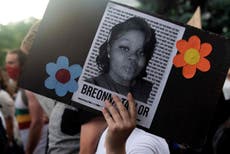Trump wants to be the ‘law and order’ candidate – but his failings in office make him a hypocrite
Richard Nixon ran on a similar platform, but not as an incumbent. Order has never been a word associated with the president’s White House and even the military are wary about his interpretation of his powers

Donald Trump has the highest disapproval rating of any US president in recent history at this point in office, at 54 per cent. Joe Biden leads him by 10 per cent in recent polls. But it would be unwise to write off Trump in the coming election, just as it would be unwise to underestimate the power of fear.
The president’s inflammatory tweets during the current protests, the use of tear gas and rubber bullets on demonstrators so that he can make his way to a photo opportunity, the threat to use military force on the American people, and the usual untruths he has peddled have led to intense criticism.
The broad and constant theme of Trump’s tweets now – as the regular sign off shows – is “LAW&ORDER”. He will, without doubt, present himself as the law and order candidate in the election, portraying the Democrats as weak, or even supportive of, lawlessness and crime. The scenes of violence, in this context, are helpful in that regard. The New York Times reported “some in the president’s circle see the escalations as a political boon” – a view echoed by others.
The theory is that as there are more instances of looting and arson, daily skirmishes in the streets, the sympathy and understanding shown to the protests would turn to unease and apprehension among those already deeply worried about the effect of the coronavirus pandemic on their livelihood.
Trump has focused on denigrating the protestors, calling them “thugs”, “criminals” and “anarchists”. He has declared that he will designate Antifa a terrorist organisation, something which would be extremely difficult to achieve in law given that the group is a loose alliance of activists. But Trump and his supporters will be demanding to know whether Biden and the Democrats support banning an organisation which the right-wing media have repeatedly accused of being dangerous and subversive.
Trump has already gone down the law and order route before.
“In this race for the White House, I am the law and order candidate. When I take the oath of office next year, I will restore law and order to our country,” he declared in 2016. The “this American carnage stops here” line in his inaugural address was about the loss of American jobs and vanishing industries, but is also thought to refer to crime. George W Bush’s overall reaction to the speech, if one recalls, was “that was some weird s***”.
Trump has also threatened to unleash the military against the protestors. But this has backfired to a large extent. A number of highly respected former commanders, including James Mattis, the former defence secretary who resigned, John Allen, the former commander in Afghanistan and Mike Mullen, former chairman of the joint chiefs of defence, coming out with damning and unprecedented criticism of a president.
They accused Trump of ordering unprovoked attacks on peaceful demonstrators by the police and the national guard, trying to dismantle democratic structures and introduce authoritarianism, and attempting to politicise the country’s armed forces.
The warning that Trump is not only unfit to be in office, but that he is actually a danger to the country, may not affect the true hardcore of his support. But it is likely to be listened to by floating voters who took a punt on Trump in 2016, as well as mainstream Republicans who are dismayed by what has been happening under the current administration.
The response of Trump – who avoided the Vietnam draft – to criticism from the military has been to insult them in his tweets, and accuse them of being overrated. He has also claimed he is tougher than them. That, according to polls, has not gone down well.
Last October, Trump claimed success in his law and order drive, telling the International Association of Chiefs of Police: “We have taken bold action to reverse the tide of violence”. It is true that crime figures had dropped in the previous three years. But that had been the trend for almost two decades, apart from a sudden spike between 2015 and 2016. So domestic crime figures should not hand him victory.
The analogy being drawn between the coming election is with Richard Nixon ‘s victory in the wake of the 1968 riots. It was certainly a time of great turbulence. There were regular, increasingly radical, anti-Vietnam war protests. The Black Panthers and the Weathermen were armed activists far more formidable than Antifa. Violent protests were particularly fierce that year following the assassination of Martin Luther King and the Democratic National Convention in Chicago. Along with all that, the crime figures were steadily rising.
Writing in the Washington Post, Kevin Kruse, history professor at Princeton, pointed to the proposal of Kevin Phillips, a Republican strategist, that Nixon “should continue to emphasise crime, decentralisation of federal social programming and law and order” to win over white voters.
Getting white Democrats on board, Phillips maintained, would create a political realignment that would usher in what he called “the emerging Republican majority”. The “fulcrum of the realignment”, he added “ is the law and order/Negro socioeconomic syndrome.”
Nixon stressed the law and order issue continuously during the campaign. One of his main adverts was of violent protestors and armed police officers, with a suitably grave soundtrack and Nixon saying: “I pledge to you, we shall have order in the United States.”
It worked for Nixon, but it will not work, Kruse believes, for Trump. Nixon won, he argues, because he was not the sitting president and could blame the Lyndon Johnson administration for the state of law and order. “If we are to restore order and respect for law in this, there is one place we are going to begin. We are going to have a new attorney general of the United States of America” said Nixon in his inauguration speech.
But this need not apply to Trump. His presidency has been marked by him blaming other people for his failures – the media, the so-called ”deep state”, the Democrats, the Republicans who do not agree with him and people in his own administration. An administration which has seen an astonishing number of departures. Trump has already got a new attorney general having blamed the previous one for all sorts of things.
The US, like other countries, will be facing huge economic problems due to coronavirus. Trump will blame others for it, mainly China, His supporters are unlikely to care that he praised Chinese handling of the pandemic no fewer than 15 times as it spread across the world, including to the US.
Facing jibes that he was hiding in the White House bunker while anger spread following the killing of George Floyd, Trump got protestors cleared from front of the White House so that he could walk out to be photographed outside a church. Holding up a Bible he declared: “I am your president of law and order. Where there is no justice, there is no liberty.” Trump-supporting Fox News host Laura Ingraham tweeted: “Strength. Freedom. Justice. Rule of Law.”
John Allen described what had unfolded as: “The slide of the United States into illiberalism may well have begun on 1 June 2020. Remember the date. It may well signal the beginning of the end of the American experiment . It wasn’t enough that peaceful protestors had just been deprived of their first-amendment rights – this photo-op sought to legitimise that abuse with a layer of religion.”
We will have to wait until the election in November, the most important in recent times, to see which version of justice, freedom and rule of law the American people want to follow.



Join our commenting forum
Join thought-provoking conversations, follow other Independent readers and see their replies